Hermeton-sur-Meuse Jumbo Tank - Moved
When I first went to Hermeton-sur-Meuse in 1991 a large rare heavily armoured M4A3E2(75) Sherman Jumbo tank was positioned by the side of the road with its gun pointing towards the other side of the trees as if waiting for the German tanks to appear on the other bank. It is no longer there.
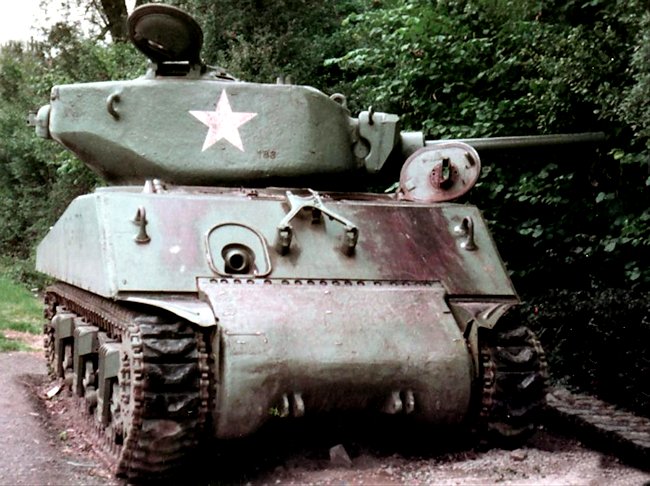
This M4A3E2(75) Jumbo Sherman tank was the Belgium village of Hermeton-sur-Meuse's Battle of the Bulge memorial. It was restored and moved to Brussels (Photo:Trevor Larkun 1982)
Specification
The M4A3E2 Assault Tank was given the nickname 'Jumbo' after the war. In the American military magazine 'Signal' there was a picture of the M4A3E2 and the caption underneath read 'This jumbo tank ...' There was some confusion. Readers thought it was called the Jumbo. The name stuck.
It had extra armour fitted (including 1 inch on the front) and a vertical sided curved turret. The hull was welded and now had a maximum frontal armour thickness of 4 inches (101.6 mm): the same as a Tiger tank. It was heavier because of the additional armour which meant that the Sherman Jumbo was about 6 mph slower than a normal Sherman tank. It weighed around 42 tons: six tons heavier than the regular combat Sherman.
The tank was powered by a Ford GAA all-aluminum 32-valve DOHC 60-degree, V8 engine, 525 HP, V8 gasoline petrol engine. It had a maximum road speed of 22 mph (35 km/h). The tank had an operational range of around 120 miles (193 km) before it needed refueling. It needed a five man crew: commander, gunner, loader, driver, co-driver/machine gunner.
Permanent grousers, known as duckbills, were fitted to the tracks to improve the ride. 254 were produced but only 250 were sent to Europe. They started to arrive in Europe in the autumn of 1944. The tank was armed with a standard 75mm gun that could fire high explosive HE artillery rounds as well as armour piercing AP shells. It could penetrate the frontal armour of a Panzer IV tank but not the front armour on the Panther or Tiger tank. To do any damage to their side or rear armour they had to get close.
The Jumbo and the Firefly story
In 1948 the Jumbo Sherman tank was offered to Dr Paul Michel, a local dentist, for use as a war memorial. He helped save many lives during the battle for the River Meuse 1944-45 as he turned his house into a medical centre. When he died the heirs of his estate claimed the Jumbo tank as their own. When the ownership of the tank was investigated it appeared that the US Army still owned the tank.
The US government started negotiations to get it shipped back to America because it was rare and worth a lot of money. They were not happy it was just left by the side of the road as a war memorial just rusting away. After a year of talking a strange deal was agreed to. The Jumbo tank would stay in Belgium. It would be restored but kept by the Royal Museum of Armed Forces and Military History Brussels (Le Musee royal de l'Armee et d'Histoire Militaire).
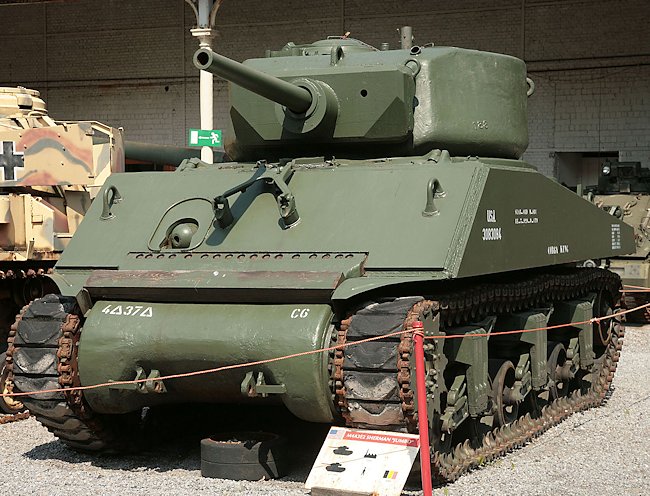
The restored M4A3E2(75) Jumbo Sherman tank that was previously in Hermeton-sur-Meuse photographed in the quadrangle of the Royal Museum of Armed Forces and Military History Brussels
This M4A3E2(75) Jumbo was moved from the Brussels Military museum during the recent redistribution of some of its exhibits and was held at the depot of the Royal Museum of the Armed Forces, in Landen, Belgium. Its Serial Number is 50511, the correct Registration Number is 3083108. It is now on display at Bastogne Barracks.
The village of Hermeton-sur-Meuse still wanted a tank as a war memorial. They were offered the hull of a British Sherman Firefly. Its 17pdr gun and turret had been destroyed beyond repair so it was fitted with a standard 75mm gun turret. As you can see from the photos it was originally called 'Battling Annie' but in 2016 it received an new coat of paint and identity. She is now called Doly. Is that a spelling mistake? Shouldn't it be Dolly?
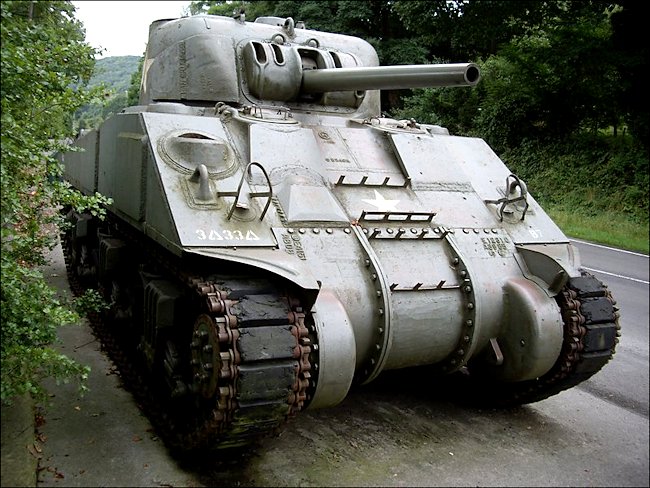
This preserved British M4A4 Sherman Vc Firefly Tank hull has been retro fitted with a 75mm gun turret and is now the Belgium village of Hermeton-sur-Meuse's Battle of the Bulge memorial.
Gallery
Here are some more photos of the M4A3E2(75) Sherman Jumbo tank when it was Hermeton-sur-Meuse's Battle of the Bulge memorial.
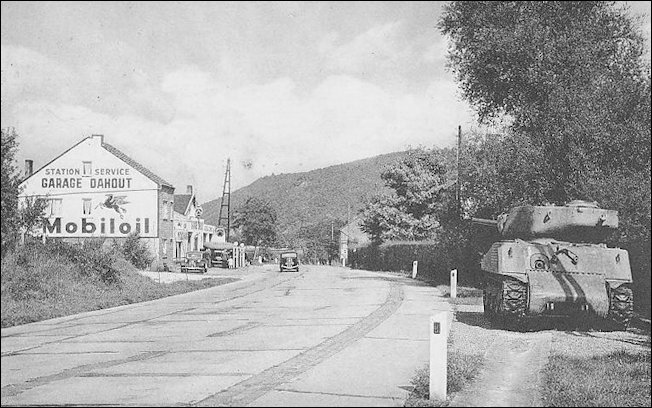
(Photo:Rolandos)
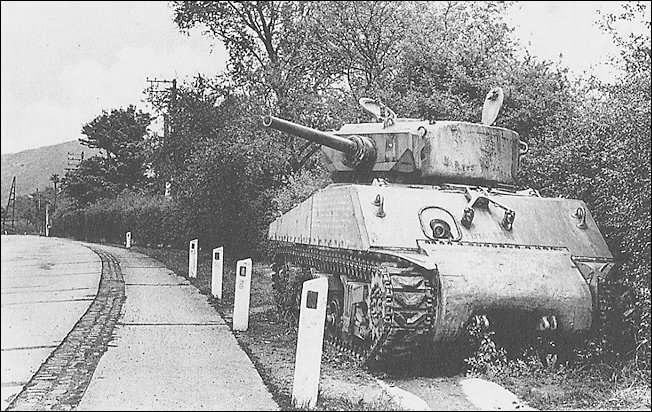
(Photo:Lecerfjm59)
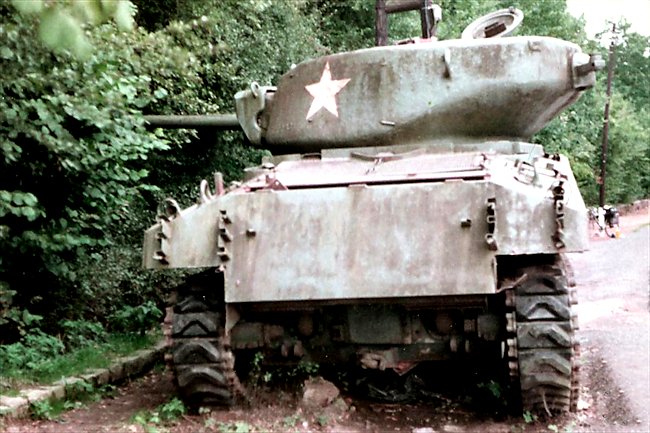
(Photo:Trevor Larkun 1982)
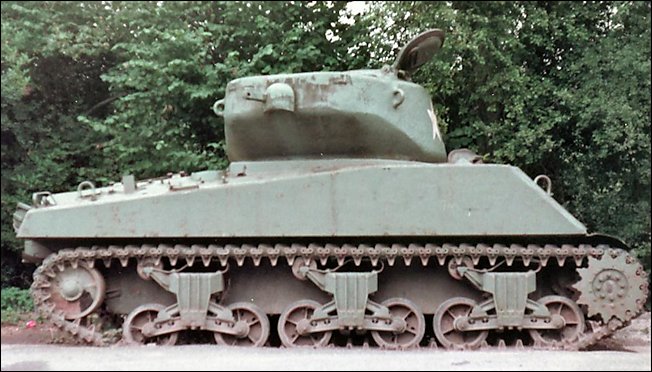
(Photo:Trevor Larkun 1982)
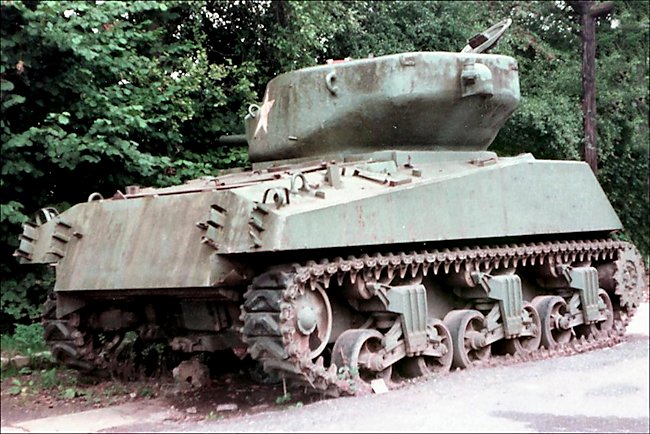
(Photo:Trevor Larkun 1982)
Cobra King
This M4A3E2 'Jumbo' Sherman tank has been made to look like the first Sherman tank in Bastogne, the 'Cobra King'. It relieved the German seige. The real Cobra King is in America. After th battle at Bastogne it was upgunned to a 76mm but then knocked out at Vilseck during the the disastrous Hammelberg Raid in March 1945. It was taken back to America and exhibited at the Patton Museum of Cavalry and Armor at Fort Knox.
During the German winter offensive, the Battle of the Bulge, an important crossroads town in Bastogne, Belgium had been cut off and surrounded by German forces. Patton's Third Army was tasked with trying to break through the German lines in the south with the 4th Armored Division as the main spearhead of this counterattack. On December 26, 1944, Lt. Boggess, commander of Cobra King was fighting his way on the road from Assenois, Belgium to Bastogne.
Cobra King was way ahead of the rest of the column and had just destroyed a German bunker along the road when Boggess spotted several uniformed figures in the woods near the bunker. They wore the uniforms of U.S. soldiers, but knowing how Germans were disguising themselves as Americans, he maintained a wary eye. He shouted to the figures. After no response, he called out again and one man approached the tank. "I'm Lieutenant Webster of the 326th Engineers, 101st Airborne Division. Glad to see you." With that meeting at 4:50 p.m. on December 26, 1944, Patton's Third Army had broken through the German lines surrounding Bastogne.
After doing more research and discovering a post-war photo of an M4A3E2 Jumbo at a repair depot in Lager Hammelburg that had matching characteristics of Cobra King, the theory was presented that this was Cobra King and that it had participated in "Operation Hammelburg," the controversial mission which was personally ordered by Third Army commander General George S. Patton.
The operation took place on March 26-28, 1945 with the official purpose of liberating a prisoner of war camp, OFLAG XIII-B, near Hammelburg, Germany. But unofficially, its purpose was to free Patton's son-in-law, Lieutenant Colonel John Waters, who was taken prisoner at Kasserine Pass, Tunisia, in 1943.
A small task force comprised of men and vehicles from the 37th Tank Battalion and 10th Armored Infantry Battalion commanded by Captain Abraham J. Baum, was formed. Task Force Baum consisted of M4A3 Shermans, M5A1 Stuarts, M4/105 Shermans, jeeps and halftracks. The total strength was 314 men and 57 vehicles.
The task force fought through German lines with serious losses and reached Hammelburg and liberated the camp, but Patton's son-in-law was wounded and had to be left behind. Ultimately the entire operation was a total failure when German forces in the area eventually overwhelmed the small task force, destroying or capturing all vehicles and capturing Baum and almost all of his men and the liberated POWs.
Since Company C of the 37th Tank Battalion was in this raid, it leads to the question - did Cobra King participate in the ill-fated Hammelburg mission? In the book RAID!: The Untold Story of Patton's Secret Mission by Richard Baron, Major Abe Baum and Richard Goldhurst, Baum stated that a tank named "Cobra King" commanded by Lt. Nutto was knocked out and abandoned on March 27, 1944 as it approached Hammelburg. But some historians have discounted this entry citing that the need for speed was essential on this mission and that a heavy, slow-moving Jumbo would be a hindrance.
Through these observations of Cobra King and research, then Patton Museum curator Charles Lemons proposed at the time the following: "Cobra King is slowly revealing its secrets. The Patton Museum staff and volunteers have been brain-storming over the implications of what we have been finding. We all agree that this is "Cobra King" - no doubts what-so-ever. What the big question has been - what happened to the tank after December 26, 1944."
"We can safely state that the vehicle remained in the 4th Armored Division - and remained as the command tank for Company C until its demise in combat. Yes, in combat - in fact the information we have indicates that the vehicle met its end in March of 1945. We firmly believe that Cobra King was lost with the rest of Company C, 37th Tank Battalion, and Task Force Baum, on the raid on Hammelburg."
"Reminiscences from then Captain Baum, as written in the book "RAID!", place Cobra King at the assault on Lager Hammelburg, where it was hit and put out of action. Unfortunately, Abe Baum does not note the damage."
"However, what we have for Cobra King is a busted #3 road wheel assembly on the left side and evidence of a fire and subsequent small arms ammunition cook-off inside the BOG (bow gunner) position. We have a vehicle that was recovered and taken to, of all places, Lager Hammelburg, where it was left in the yard until the mid-1950s.
"Further, C Company was only informed less than a day before the action, having been selected because it had the most tanks of the battalion. No commander would have abandoned one of his strongest vehicles - a Jumbo with a 76mm main gun and .50 caliber coax - nor could he abandon his own command vehicle. Interviews with Brigadier General Jimmie Leach, B Company Commander, 37th Tank Battalion, show that even when in a hurry the tanks rarely traveled faster than 15 mph to avoid losing the infantry support, so a marginally slower vehicle wouldn't have mattered."
"Hammelburg was in the Seventh Army zone of control and 4th Armored Division, under Third Army, never came within 40 miles, with the exception of Task Force Baum. So how would a 4th Armored Division vehicle (Cobra King) end up in a Seventh Army repair facility?"
After the war, Cobra King became a monument tank, put on display at Erlangen, Germany and then from there relocated to Vilseck, Germany where it remained in obscurity, the wrong registration number painted on its side from one of its numerous repaints. In May 2001, Army Chaplain Keith Goode was checking out monument tanks while serving in Germany.
He was locating serial and registration numbers of Sherman tanks on U.S. Army bases. He passed the information on to the G104 Sherman interest group in the U.S. where member/historian Joe DeMarco confirmed that the tank was indeed the actual Cobra King.
After learning this information, another member of G104 stationed in Germany, Sgt. Brian Stigall of the Fifth Battalion, Seventh Air Defense Artillery and Steven Ruhnke, First Armored Division museum curator, paid Cobra King a visit and also confirmed the serial number and passed the information up the chain of command.
Along with other Army historians, including Patton Museum curator Charles Lemons, the identity of Cobra King was officially confirmed. Cobra King was then shipped to the United States and on to the Patton Museum's workshops on July 9, 2009 for restoration.
At first the plan was to restore the interior and exterior to the way Cobra King looked on December 26, 1944. However, the discoveries of her interior altered that plan. It was decided by then Patton Museum director Len Dyer that the exterior of Cobra King would be restored to how she looked during the Battle of the Bulge, but that the interior would be left showing interior modifications to ammo storage and the damage sustained presumably at Hammelburg.
Four Patton Museum volunteers, Don Moriarty, Garry Redmon, Coleman Gusler and Robert Cartwright were selected to work with museum staff on the restoration along with other volunteers who also contributed to the restoration.
After a two-year exterior restoration, Cobra King was as finished as possible before she was shipped out to her new home at Fort Benning, Georgia in August 2011. - Patton Museum curator Charles Lemons
Read more in these two tank books

